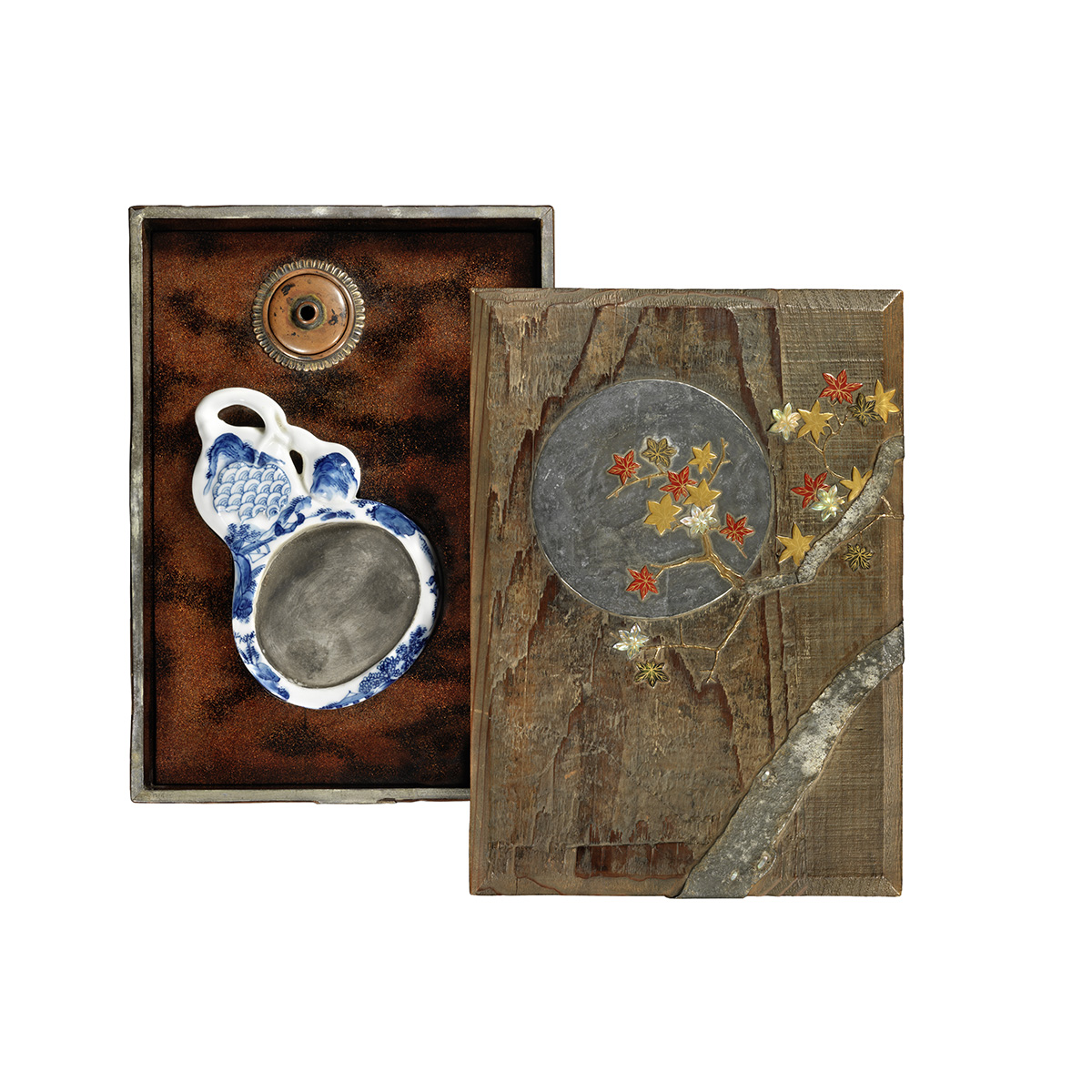Suzuribako
Lacquer
- Sold
-
Material
Wood, lacquer, copper, and Koto-yaki ink stone
-
Size
25 x 17.5 x 4.5 (h) cm
-
Period
Edo period, 19th century
-
Box
Awasebako (collector box with the mention “Made by OGAWA Ritsuō”)
-
More informations
After OGAWA Haritsu “Ritsuō” (1663-1747)
Description
Stationary box with a Koto-yaki inkstone and a copper water dropper
Stamp of Haritsu.
Box, “Made by OGAWA Ritsuō” but we are sure it is only an attribution.
This piece is a stationary box with a motif of autumn night. The maker used a round-shaped lead depicting a full moon; iron material to express the maple branch, and the lust of the iron causes the effect the old tree. The leaves of maple were made with red and gold lacquer, mother of pearl, and glass fragments. On the backside of the cover, a stick and hat were depicted with maple leaves. The composition the maple leaves on the moon is extremely beautiful.
The ink ceramic gourd-shaped is Koto-yaki, which is extremely rare to find these days (see below). The water dropper is in copper. Despite the lacquer consistence of the board for these stationary and the backside of the cover are same, and the stamp of Haritsu on the backside of the cover, this stationary is not original but a work done in the style of Ogawa Haritsu in tribute to this artist.
Koto wares (Koto-yaki) were ceramic products made in and around Hikone Castle of Ominokuni (Shiga Prefecture). The first kiln is said to have been the Kinuya kiln (in the castle town of Hikone), which started operation around 1829. In 1842, it fell under the protection of the Hikone clan as a clan-operated kiln and its size was expanded and techniques were improved. The aim was to produce high-class ceramic products. It was Ii Naosuke, the 13th lord of the Hikone clan, who was the most eager to produce ceramics. (More about the Ii clan can be found by doing a web search for Hikone on Google.) He invited potters from all over Japan and summoned painters such as Kosai and Meiho from Kyoto, thus trying to improve the wares. However, Ii was killed by assassins outside of the Sakurada Gate in 1860, and thereafter Koto wares lost the protection of the clan. It then turned into a privately-owned kiln, known as the Yamaguchi kiln, and continued in operation until 1895. Many superior works were made, such as Aka-e kinsai, blue and white porcelain, and a wide variety of other wares such as celadon, and copies of Ko-Kutani, Oribe, and Ninsei.
“The Grace and Workmanship of Porcelain: Unfolding Developments in Japan”, exhibition catalog from the Aichi Prefectural Ceramic Museum and the Seto Folk Museum, 1998. Today Koto wares are highly valued and good ones hardly ever come on the market.
OGAWA Haritsu was a lacquer artist, painter (ukiyo-e), and haiku poet. Ritsuō is his other name as artist. He invented his own technique of lacquer, using many kinds of substances like lead, gold, silver, copper, iron, fragments of ceramic, ivory and glass into the wooden piece with maki-e lacquer. His style was called “Haritsu work”, and loved by flashy people of those days. His work influenced the later artists, like Shibata Zeshin.
- The old paper inside is an explanation about OGAWA Haritsu, most probably written by ex-owner.
